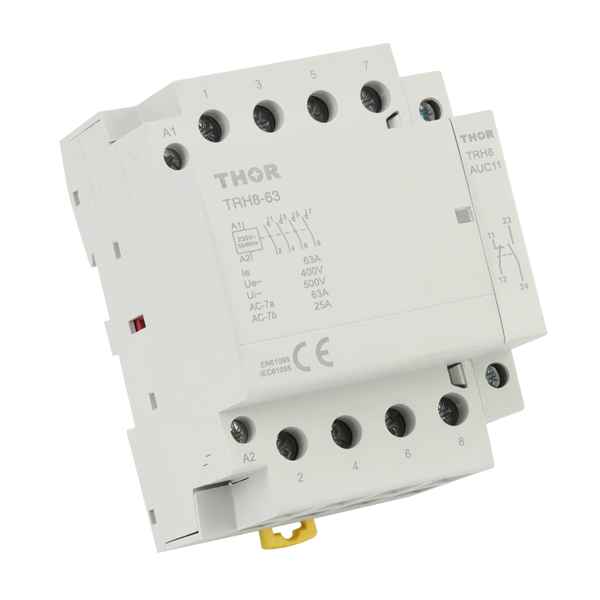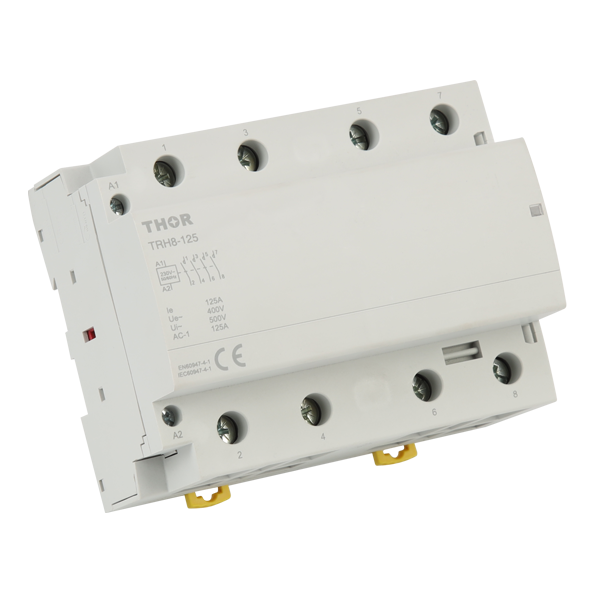A contactor is one of the key electrical units in power control systems and also affects circuit on-off with electromagnetic principles. They are widely used in industrial and civil power systems, especially in motor control, lighting systems for big machines, and automation equipment. They make it possible to switch devices through remote signals, providing safe and convenient operation of high-power connected equipment.
Basic Structure
In general, a contactor is made up of four parts: the electromagnetic system, contact assembly, arc extinguishing device, and housing. A contactor primarily consists of a coil and electromagnet as its core components using the electromagnetic system. Activation of the coil magnetically generates a field that attracts the armature and closes the contacts. The design and the related choice of material for a coil determine its usage; typically, it is made from high-conductivity wire or cabling to help improve energy efficiency and longevity.
The contact system includes main and auxiliary contacts. The main contacts control the increase or decrease of current in the coil; they are generally made of silver alloy material with high-temperature resistance and good conductance properties (or pure copper-based standard contactors), which guarantees stable working performance when bearing a heavy load. Auxiliary contacts are used in control circuits or signal circuits to provide status feedback and control commands. To prolong service life, they are usually coated with a surface layer, including special treatment to improve wear and corrosion resistance.
The arc suppression device plays a vital role in protecting the contactors. An arc extinguishing device, such as an arc chute or grid, suppresses the creation of arcs when contacts are opened, thereby preventing contact erosion. The arc generated by the sudden interruption of current can be extinguished as quickly and effectively as possible, protecting contactor contacts to prevent their erosion or melting away, providing longer service life for devices. The housing is made of high-strength insulating material that shields the internal electronics and keeps dust or humidity from reaching inside.
Working Principle
The electromagnet induces a magnetic field when the coil is energized, which then draws the armature in, causing the actuation of main contacts as they close and establish a circuit connection. This process is designed by the electromagnetic system to enable the contactor both a fast response time and secure maintenance of its closed state during coil de-energization. This is because the electromagnetic force also depends on the number of turns and frame size for a given coil current (so it has to be designed suitably for any specific case).
As soon as the coil gets de-energized, the magnetic field vanishes, causing the armature to move back rapidly by spring force to its initial position, which opens the main contacts, hence disconnecting the circuit. To prevent the contacts from being damaged under normal conditions, it is necessary to quickly eliminate the generated arc in a process called clipping. When the arc is stretched out and air-cooled, it will quickly get cold, and its power is gradually dissipated; thereby ensuring that very little heat affects the region of the contactor's contacts.
In industrial direct current applications, contactors are generally used to switch a circuit on or off (or in the case of a reversing contactor, switching two circuits either on or off), but they are not rated for rapid-acting overload protection. When overloaded, the thermal relay moves automatically to cut off the contactor to protect the motor from damage. Contactors have very fast response times and a high degree of reliability, making them an essential part of industrial controls.


Classification of Contactors
Contactor classification can be done according to different criteria. According to the current type of use, contactors are divided into AC contactors and DC contactors (DC circuit breakers). AC contactors are used in AC circuits and have good arc extinguishing capability and high current carrying capacity, whereas DC contactors, meant for DC circuits, have a more focused design to prevent or suppress fire arcs.
Contactors are divided into single-pole contactors and multi-pole contactors based on the number of poles. Single-pole contactors are usually used in simple single-phase circuits, while multi-pole ones provide the ability to start and stop three-phase power supplies simultaneously with one device. With multi-pole contactors, each contact is coordinated to perform in a manner that keeps the circuit safe and stable.
According to the working method, contactors can be divided into two types: electromagnetic AC contactors and static contactors. Electromagnetic contactors operate through electromagnets to actuate contacts opening and closing, while static contactors use semiconductor devices for completely switching without any mechanical switch. Static contactors do not have mechanical moving parts, thus providing greater reliability and service life in high-frequency applications.

Precautions
For equipment safety and stability, it is important to select, install, and maintain contactors correctly. Choose the appropriate contactor based on heavy load current size, voltage level, and working environment. Poor selection of the contactor can result in overload or energy waste, which would not allow it to work properly.
Contactors must be installed in airtight, dry places well protected from sunlight and should not work properly if dust or moisture enters. Terminals need to be tightened and reliable; loose terminals can result in circuit power failure or equipment damage.
It is necessary to check the wear and oxidation condition of contacts regularly. If there are worn-out or dirty contacts, they should be cleaned or replaced in time, as this will affect electrical contact performance. Also, inspect the winding insulation of the coil for any evidence of overheating or wear. Maintenance and replacement should be carried out in a completely disconnected state of power supply; measures to avoid electric shock must be taken safely.
